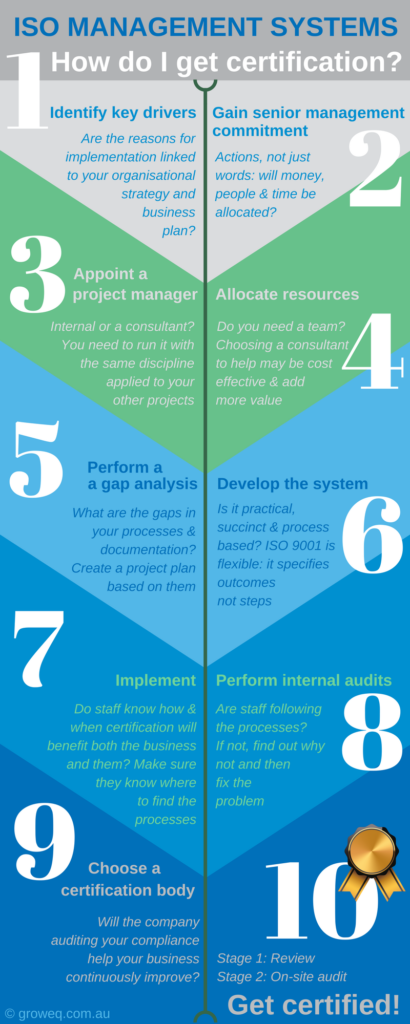10 Frequently Asked Questions — ISO 9001
1. What is ISO 9001?
ISO stands for the International Organization for Standardization, the body that develops a number of international standards. But that would be IOS wouldn’t it? ISO gives this explanation of the name: “Because ‘International Organization for Standardization’ would have different acronyms in different languages (IOS in English, OIN in French), our founders decided to give it the short form ISO. ISO is derived from the Greek isos, meaning equal. Whatever the country, whatever the language, the short form of our name is always ISO.”
ISO 9001 is short for ISO 9001:2015 Quality Management Systems Requirements. It explains all the requirements an organisation must meet in order to be certified to this Standard. These requirements can be applied by any organisation, no matter what their products or services are, large or small, public or private or not-for-profit. Because of this, it’s very flexible. It doesn’t tell you exactly what to do. Your organisation must figure out the best way of meeting the requirements — and this can be both a challenge and a blessing.
The Standard does not define the specific quality of your product or service. Instead, ISO 9001:2015 helps you achieve consistent results and continually improve your processes. In fact, it goes beyond what many people would traditionally call “quality”. At GrowEQ we think of it as a management system, full stop. It is a framework for managing a business that is used by over 1.6 million organisations in over 175 countries. It can, when applied skilfully, result in cost savings, greater customer satisfaction, improved profit margins, and even happier employees. It can enhance business outcomes and create long-term sustainability. You can read more about the benefits here.
2. How is ISO 9001:2015 different to AS/NZS ISO 9001:2016?
No doubt about it, this is unnecessarily confusing. The naming of AS/NZS 9001:2016 reflects the fact that the organisation known as Standards Australia approved ISO 9001:2015 in the year 2016. Standards Australia is the peak non-government Standards body in Australia, which works in tandem with Standards New Zealand to develop joint Standards.
Essentially, there is NO DIFFERENCE between ISO 9001:2015 and AS/NZS ISO 9001:2016.
Similarly, for Environmental Management Systems, there is NO DIFFERENCE between ISO 14001:2015 and AS/NZS ISO 14001:2016.
3. What are the Quality Management Principles?
These are the principles central to ISO 9001 and the concept of Quality Management:
Customer Focus – understanding who your customers are, their strategic importance, and their needs and expectations.
Leadership – top management must be accountable for the Quality Management System, provide resources to make it work, make sure that it produces the expected outcomes, and support other managers in showing leadership.
Engagement of People – all staff should be encouraged to understand and contribute to the Quality Management System. Communication with and from staff, so they’re committed to the Quality Management System, is crucial to its success.
Process Approach – application of the process approach enables understanding and consistency in meeting requirements, effective performance, and the ability to measure and improve (which you will know how to do, by this stage).
Improvement – continual improvement is the most fundamental of all the Quality Management principles. Plan your strategy, implement it, measure the performance, and modify it. Together, these steps equal improvement.
Evidence-based Decision Making – your Quality Management System must not be based on instinct. Measure the important results and use them to make the important decisions.
Relationship Management – this refers to your organisation’s relationship with all stakeholders, not just customers. Your organisation should try to satisfy their diverse needs and expectations.
These principles underlie all aspects of the ISO 9001 Standard and are the basis of any good Quality Management System.
4. What is a Certification Body?
A certification body is an organisation that is accredited to audit and certify other businesses. The terminology used here is important and shouldn’t be mixed up. So you should say “our business is certified to ISO 9001,” but not “our business is accredited to ISO 9001. It might seem pedantic, but by using the correct words you demonstrate that both you, and your organisation, know what you’re talking about. You sound credible to your existing and potential customers.
Certification bodies are audited by JAS-ANZ the Joint Accreditation System of Australia and New Zealand. JAS-ANZ doesn’t certify or inspect organisations, products or people. Rather, it accredits the certification bodies and auditors that provide those services, by developing the assessment criteria they must meet.

When you need an audit to achieve certification to ISO 9001, ISO 14001, ISO 45001 or another standard, you must first make sure your management system will stand up to close scrutiny.
This is where a company like GrowEQ comes in. We help you undertake a gap analysis, develop your management system, provide implementation assistance and training, conduct internal audits and then provide ongoing support. We can also help you choose a certification body, facilitate your certification audits and maintain your post-certification audits — we speak their language and know the best ways to meet their requirements.
You can check out our tips for choosing a certification body at Is Certification Worth it?
5. What is ISO Certification?
Certification to ISO 9001 (or any of the other ISO management system standards) means that you have successfully passed an audit by a certification body.
The certification body will issue you with a certificate that has your organisation’s unique JAS-ANZ registration number on it. Your organisation will be listed on the JAS-ANZ Register of certified organisations located here. Anyone can search this Register.
Your certificate will be valid for 3 years, but the certification body will audit you at least annually to check that your organisation is still meeting the requirements of the Standard. These are called post-certification or surveillance audits, and only half of your management system will be audited at this time. However, every 3 years your entire system will be audited and a new certificate issued to you. These are called recertification audits. You can read more about certification here.
6. What are the Benefits of ISO 9001 Certification?
It’s NOT just about the certificate, although being certified does allow businesses access to more tenders, and convey to the world that they’re using best practice.
A well-constructed management system that’s certified to ISO 9001 also conveys these benefits:
- You now have defined, documented and repeatable processes, which eliminate inefficiencies and get the job done the right way every time.
- You know quickly what’s going wrong and where, and you have a system in place to fix it.
- Your business functions in a disciplined manner — there’s a systematic way of dealing with any issues that arise.
- Inefficiencies with old problems are eliminated and new problems are dealt with in an efficient fashion.
- Reporting becomes controlled and efficient, so you know where your business is at any given time.
- The endorsement of certification opens doors to markets that you haven’t had access to before.
- You have fewer failures with product quality or services.
- ISO 9001 is all about improvement — your business is now on a path to continual improvement.
You can read more detailed analysis of the benefits here.
7. How Do I get ISO Certification?
The simple answer is that you can manage Certification yourself. But you should consider the time and expertise involved, when weighing up whether getting a specialist to do the job would make better business sense.
Do It Yourself
If you choose to do it yourself, there are 10 logical steps to follow — take a look at our infographic for a brief overview.
Let GrowEQ Do It For You
Thanks to our vast experience, at GrowEQ we’ve been able to streamline getting ISO certification. You can read more about our proven 5 step approach here.
*
*
*


8. How Long Does It Take To Get Certified?
Three months is a realistic amount of time to allow for the process of developing and implementing an ISO 9001, ISO 14001, ISO 45001 or any other management system.
The certification body will expect to see about 3 months’ worth of records. This proves that you have a history of improvement and your management system isn’t a one-off wonder. But development, implementation, and record generation can occur concurrently thus reducing the time required to get certified.
It can be done faster. If your business already has a good management system in place, even if it’s an informal one, we may be able to expedite the process considerably.
We can also provide you with a Letter of Engagement that you can submit with your tender documents, to show your organisation will be certified soon. Many businesses find our 5 step approach very helpful.
9. Can I Do All The Work Myself?
You can. Perhaps the question you need to ask is “Should I do all this myself?”
For an inexperienced person, writing and implementing a management system that achieves ISO certification is a mammoth undertaking. The investment of time and money is likely to be poor value compared with engaging a consultant, especially if the result is sub-optimal because of a lack of detailed knowledge and expertise.
At GrowEQ, we’re experts at taking businesses through the stages of ISO certification — and we’ll get you there in a timely and efficient manner, with great value for your money.
10. Should I Get A Consultant To Help Me Achieve Certification?
Engaging a consultant is likely to be the most efficient and cost-effective way of achieving certification. When you consider the false starts and errors that you’re likely to make in developing your quality, safety or environmental management system, you soon realise that you could be wasting a great deal of time and money. Using a consultant who helps organisations get certified for a living, and has been down this road many times before, is a very sensible alternative.
A good consultant should design a system for you that’s low on paperwork and big on ease-of-use. It must be practical, succinct and easy to follow. It must add value to your organisation (see What are the Benefits ISO 9001 Certification?).
One of the other added benefits of using a consultant is having a “fresh set of eyes” take an objective look at your business. An experienced outsider can often detect issues that insiders can’t, and suggest improvements that might not be considered otherwise. A good consultant brings the experience of other businesses to the table — they’ve seen different ways of doing things in diverse organisations, and should be able to advise on the best way for your business to operate.
Think of a consultant as a short-term employee — you may not need a full-time, permanent Quality Manager, but you do need one for a while. So make sure you hire a good one! Here are some tips on choosing a consultant.


